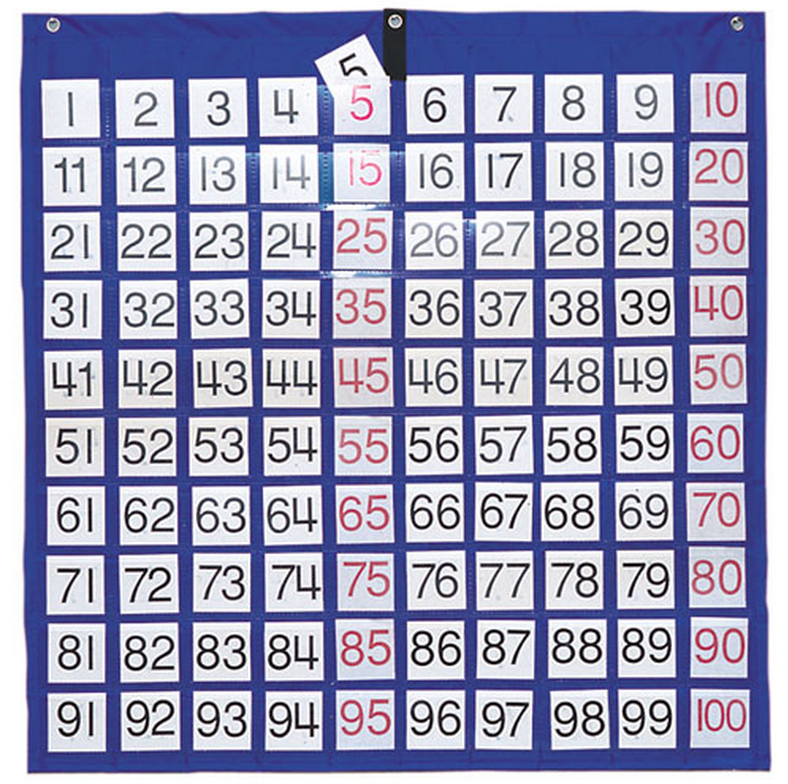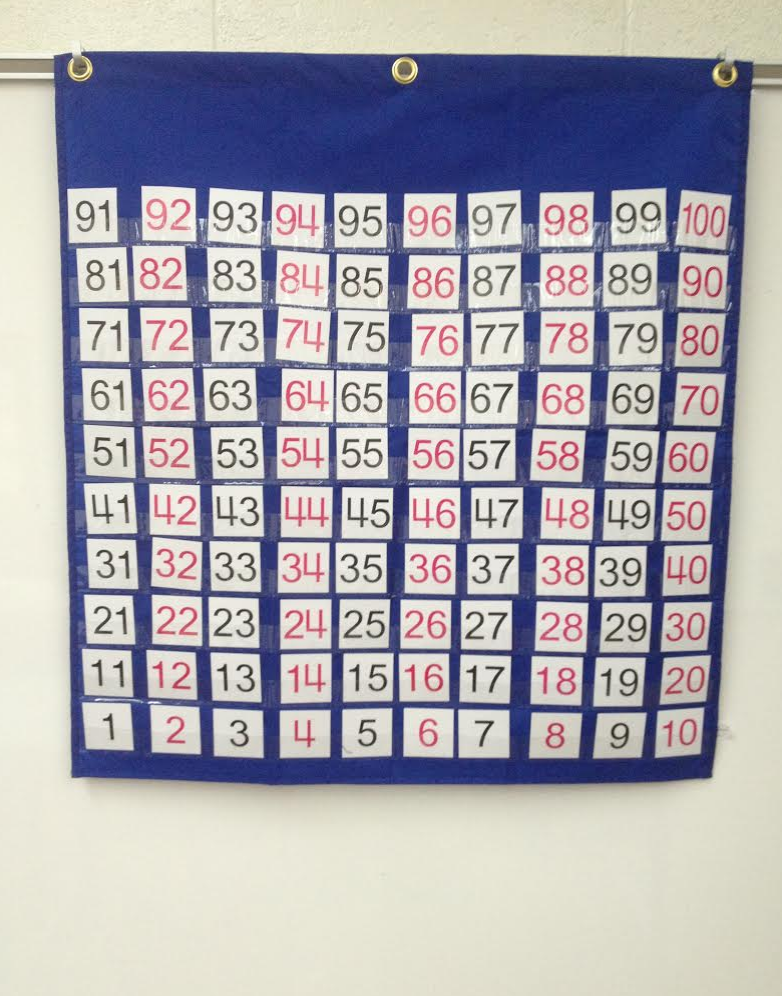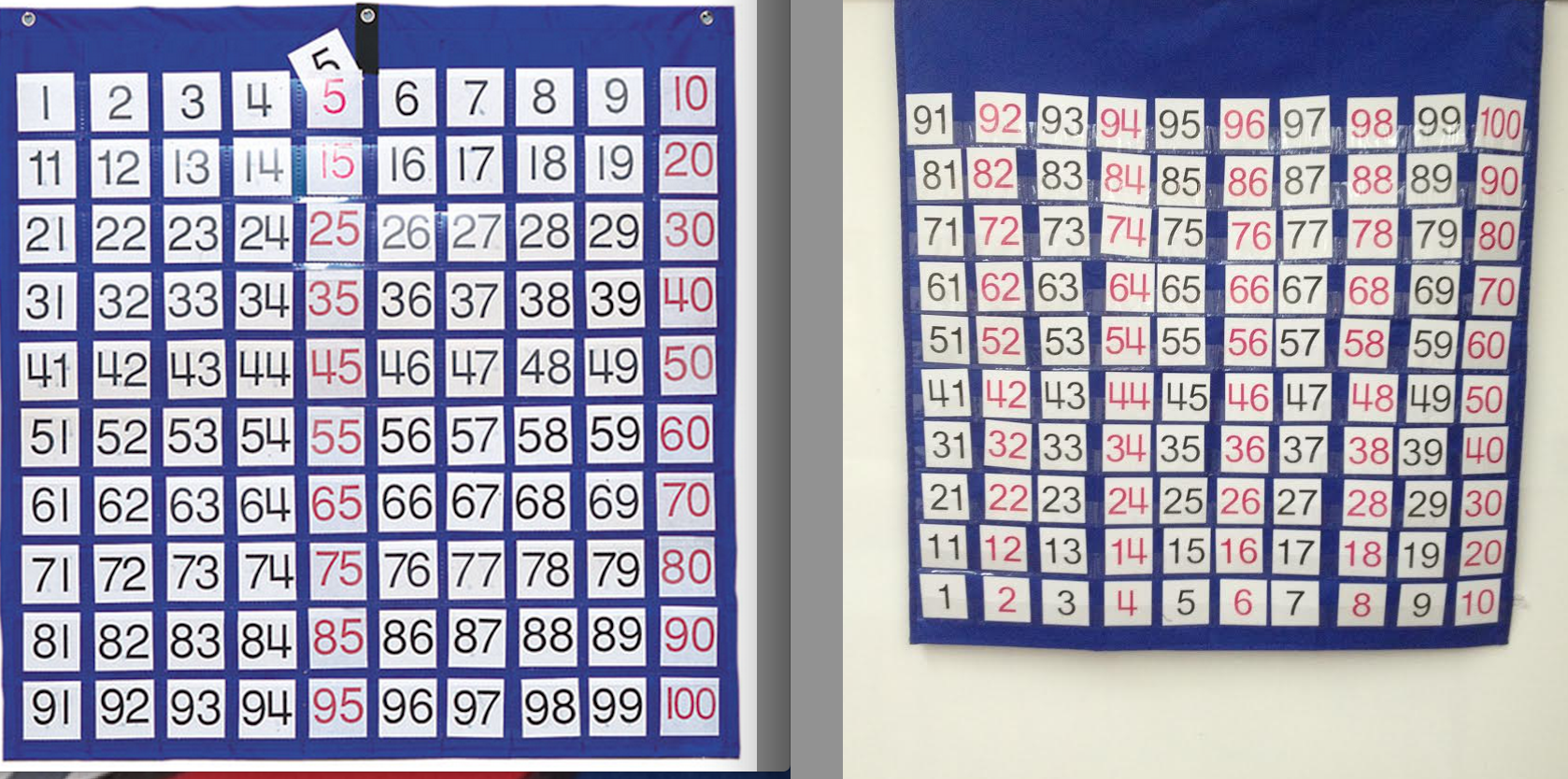The concept of 10 more/less is a beast in the primary grades. Last week I realized that I’ve been feeding the monster that I’m continually trying to defeat. Almost every day, in every K-2 classroom across the United States students encounter this guy:
I made a conscious effort to pop my head in every K-2 classroom in the schools I visited this week. It was great to see that every classroom had a traditional 0-99 or hundreds chart posted like one above.
While visiting, one of the teachers asked if I could come back today and model a lesson using a 0-99 chart because her students “just weren’t getting it.” I gladly accepted her invitation and showed up with this guy:
I didn’t use manipulatives for this lesson because I was specifically focusing on the rote counting process which precedes one-to-one cardinality when counting by ones OR tens.
This 30 minute lesson is about as unscientific as it gets when it comes to research but here’s my take-aways:
- The traditional hundreds chart is counter-intuitive to how students understand and recognize number. When numbers increase by 10 or more, they go down.
- The hundreds chart is set up to mirror reading (left-to-right, top-to-bottom). But just because we do it in reading, does it mean that we have to apply that same idea to math?
- By inverting the chart and starting with zero at the bottom, students were able to explain that when the number increase by ten it gets larger/taller/bigger/greater which are all modeled when they move “up”.
- A student made the best connection EVER when she said “It’s like my carton of chocolate milk. When I drink some there’s less and it goes down. But when I spit it back in there’s more milk and it goes up.”
- I took that student’s reasoning and applied it to the traditional hundreds chart (which I didn’t share). When we put more in, it goes down. When we take milk out, it goes up. When in life does this ever happen?
It comes back to the ol’ “which way does a ten frame go?” I think students should see the ten-frame both ways. I just don’t think I’m giving the hundreds chart the same opportunity. If anyone has some or knows of official research on this please share.
If you flip the chart please let me know how it unscientifically goes!
Bottoms up and stay thirsty my friends!
Update October 2016: Jenny Bay-Williams recently shared this article from 1974 regarding a flipped hundreds chart. Not surprising to see that we haven’t changed a thing.




Using a number path with numbers to 100 (boxes with numbers inside, not a number line), I cut the path up at each 10 and stick each block of ten below (should now be above!) the other so the students can see how the chart is actually created.
Hi Graham,
I just re-read your blog post. I want to include my blog post for the same concept for kindergarten (https://themindofanaprilfool.com/2016/02/27/flipping-the-hundreds-chart/). Besides your recent inclusion of the 1974 article, there isn’t much out there. Complete bummer. Frustrating to see 1st/2nd graders using a traditional chart for adding/subtracting that doesn’t make conceptual sense. UGH!
Thank you for your inspiring work! Can’t wait to see you in Anaheim!
Right on Kristen and thanks for sharing the link. The more we can smash our heads together the better off we’ll all be.
As it works out Jenny Bay-Williams and I just had our transcript approved from this very thing in Teaching Children’s Mathematics. Once it’s published, I’ll be sure to share it here as well. We’ll build our own “Bottoms Up Library”.
Looking for to catching up in Anaheim as well.
I tried flipping my hundreds chart this week when working with an ELL student who just struggled with the words more/less but going the opposite direction on the chart when giving me hints about a hidden number. Having that traditionalist mindset that sometimes creeps back in when trying something new with numbers, I was worried I was ruining his number sense doing so but it turned out great!! Can’t wait to see if there’s researching supporting this! Great work Graham!
Right on Devon and thanks for sharing. As far as I know there is limited research that supports the use of a flipped hundreds chart.
I recently found out that this is not a new idea. In fact, Jenny Bay-Williams shared a 1974 NCTM article that addressed a flipped hundreds chart to support ELLs. Love to get your thoughts.
Here it is… https://gfletchy.files.wordpress.com/2014/10/a-new-look-for-the-hundreds-chart-1974.pdf
Reblogged this on mathkaveli and commented:
This is just awesome!
This makes so much sense. I have reworked the hundreds chart (1-120) for our teachers and now I’m wondering if it would make more sense to build addition tables and multiplication tables from the bottom up as well. Any thoughts on this?
I teach first grade and I am definitely going to share this with my staff and do it in my classroom! Great post! Thank you!
Sweet deal Teresa! Let me know how it goes or if you make it better somehow.
All of us are smarter than one of us!
I know it’s set up a bit differently, but I couldn’t help think that your “bottom up” approach is similar to a Chutes and Ladders game board. It seems to work on the same principle of moving “up” to imply distance/height. I’ll be sure to share your idea with teachers in my district to see if they’ve tried it before or to see if any want to give it a try.
I totally agree Brain…this screams Chutes and Ladders!
From the teachers in my district that have tried this idea, they really liked how quickly students were able to make the connection. Many have shared how quickly their students were able to navigate the 100s board more efficiently. If your teachers dive in and give it a try I’ll be looking for a post on you site!
I appreciate you stopping by and all the great work you’re doing moderating #elemmathchat on Thursday nights at 9:00. Cheers!
I remember reading about this idea before. It’s why I added the option to “Start Numbers From Bottom” on this http://www.helpingwithmath.com/printables/tables_charts/1nbt1-numbers-chart01.htm adjustable number chart which I’m unashamedly boasting about.
Cheers for sharing David and I’ll be sure to pass it along!
I changed all my hundred charts in my room and my students love it. My school is going to get ours reprinted for K-2!
A no brainer when you think about it!
Reminds me of this post, adapting a Russian hundred chart:
http://www.moebiusnoodles.com/2012/12/the-hundred-chart/
That’s really cool Denise. Just saved it and now I’m thinking about having some students construct it.
Thanks for sharing!
LOVE this!! It definitely makes sense. I’m about to flip the chart in some lessons this week! I’ll let you know how it goes. Thanks for the inspiration!
Cheers Lisa! Be sure to post about it on your blog, then come back here and share the link so people can read about it.
Count me in! Great idea Graham. This is related to what we’ve been talking about with “Fill the Stairs”, and it makes perfect sense.
Yep…your post (http://exit10a.blogspot.com/2014/09/a-tale-of-three-classrooms.html) was once again the culprit. Love the interstate collaboration we have going on here!
I think it would be really cool to have a “controlled classroom” that introduced number through this concept and then compare with other classrooms that use the traditional hundreds chart.
Or maybe we could sneak attack a classroom after school, change the chart and see what students have to say about it. What’s the same and what’s different.
I love this idea! Not sure about any research. This makes a lot of sense. I hope everyone reading this tries it. Maybe we’ll get some anecdotal data to support this. Again, great post!
Thanks Mike! I’ll be sure to pass along whatever goodness Christina sends our way!
I have been telling teachers this for years! I’m pretty sure I read about it first in one of the NCTM Teaching with the Focal Points books. I will have to check when I get home. Excellent post, Graham!
–Christina
Thanks Christina,
Just trying to figure out why you didn’t let me know about this sooner! If you have any more goodies (like this) that you’re keeping… shame on you:-)
If you happen to find where you read about flipping the hundreds chart please be sure to pass it along.
Just more evidence that all of us are smarter than one of us.
Cheers,
Graham